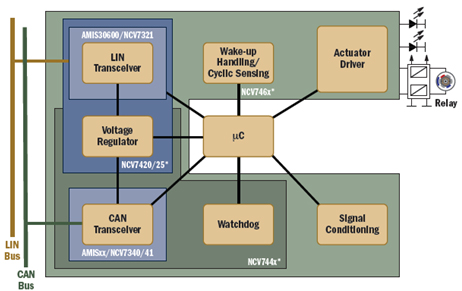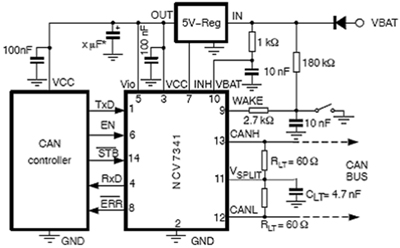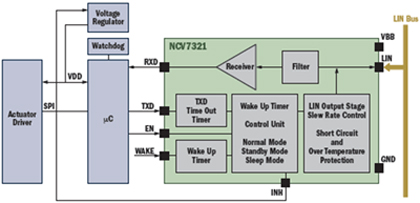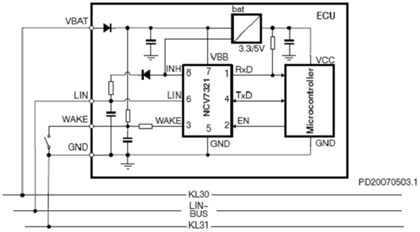In order to meet people's higher requirements for automotive performance and functionality, manufacturers are vying to use advanced electronic control technology in automotive design. With the rapid increase in the amount of information exchange within the car, an in-vehicle serial network system using multiplex transmission has emerged. Currently, the CAN (Controller Area Network) protocol has become the standard for the In-Vehicle Network (IVN) protocol. In addition to CAN networks, the industry has developed a car serial protocol LIN (Local Interconnect Network) bus for low-cost applications to support in-vehicle layered networks.
This article refers to the address: http://
As a leading automotive semiconductor solutions provider with extensive automotive expertise, ON Semiconductor's broad portfolio of automotive components offers a variety of optimized solutions for in-vehicle networks, including stand-alone LIN transceivers, stand-alone CAN transceivers, and system-level Chips, as well as FlexRayTM transceivers, offer automotive manufacturers a variety of options for improving the performance of automotive electronic systems.
Advantages of the vehicle network
With the development of automotive technology and the large number of applications of electronic technology and control technology in automobiles, more and more electronic control modules in automobiles have been developed from the original to dozens of traditional data transmission methods. The requirements for data transfer between modules cannot be met. CAN, which is increasingly popular in automotive control systems, facilitates the high-speed transmission of data from automotive control systems and makes the design of automotive control systems simpler.
At present, the CAN protocol and its network system have been widely adopted by global automobile manufacturers. The CAN protocol clearly defines the contents of the data link layer and the physical layer. CAN has excellent features to optimize performance, power consumption and electronic control unit (ECU) cost, enabling body control module, interior temperature control, seat control, electric power steering (EPS), adaptive lighting Wide range of automotive applications such as rainfall/light intensity sensors, parking aids and transmission modules.
LIN is a low-cost serial communication network used to control distributed electronic systems in automobiles. The goal of LIN is to provide accessibility to existing automotive networks (such as the CAN bus), so the LIN bus is an auxiliary bus network. The use of the LIN bus can save significant cost when bandwidth and versatility of the CAN bus are not required, such as communication between smart sensors and brakes.
ON Semiconductor's in-vehicle network solution
Currently, automakers are using industry-standard interfaces to connect distributed systems. ON Semiconductor offers a portfolio of innovative automotive networking products, including CAN, LIN and FlexRay transceivers, all certified to AEC and TS16949. The company also offers system-on-chips that integrate other circuits such as voltage regulators, drivers, transceivers, and supervisory functions. Figure 1 shows a typical system partitioning of LIN and CAN bus connections and typical devices from ON Semiconductor.

Figure 1: Typical System Division of LIN and CAN Bus Connections
Independent CAN transceiver
The latest generation of CAN transceivers deliver industry-leading electrostatic discharge (ESD) and immunity to electromagnetic interference (EMI). These devices from ON Semiconductor use proven, innovative I3T technology to provide highly rugged, high-quality components with a measured failure rate of a few parts per billion (ppb).
ON Semiconductor's NCV7341 is a CAN transceiver that acts as an interface between the CAN protocol controller and the physical bus for 12 V and 24 V systems. The NCV7341 provides differential transmission for the bus, and a high common-mode range differential receiver with excellent EMI capability provides powerful differential reception for the CAN controller. When the power supply is removed, the NCV7341 has ideal passive characteristics and is fully compliant with the ISO11898 standard at speeds up to 1 Mb. If a Split Termination voltage source is used, its VSPLIT pin splits the idle bus level to further improve electromagnetic emission (EME) performance. The device's bus topology function can connect up to 110 nodes. The digital interface's independent VIO (input and output voltage) power supply facilitates communication between CAN controllers and microcontrollers (MCUs) powered by different power supplies, so it is widely used in automobiles and Industrial network. In addition, bus pins for transient protection of automotive environments, VSPLIT pin short-circuit protection and thermal protection make this device an ideal choice for automotive applications. Figure 2 is a circuit diagram of a 5V CAN controller application using the NCV7341.

Figure 2: Application circuit diagram of 5V CAN controller using NCV7341
2. Independent LIN transceiver
The LIN bus communication and control unit has a low data rate (up to 20 kBaud) and is mainly used for non-time critical functions such as door locks, rearview mirrors, car seats and sunroofs. Each node of the LIN bus protocol uses only a single wire to minimize wiring costs. Each node of the LIN bus contains a slave MCU state machine that recognizes and translates instructions for specific functions. These products are compliant with the standards of the United States (SAE J2602-2) and Europe (LIN Physical Layer Specification 2.1 revision).
ON Semiconductor's feature-rich LIN transceiver, the NCV7321, acts as an interface between the LIN protocol controller and the physical bus in low data rate IVN applications. The NCV7321's excellent EMC characteristics and rugged system-level ESD performance of up to 13 kV eliminate the need for external ESD components and consume low power, making it ideal for demanding automotive applications. Figure 3 is a block diagram of the standalone LIN transceiver NCV7321.

Figure 3: Standalone LIN Transceiver NCV7321
The NCV7321 uses ON Semiconductor's innovative I3T technology and intelligent power technology to enable high-voltage and sensitive digital technologies to coexist on the same chip. It provides customers with an alternative to existing LIN transceiver specifications. The device is housed in a high-density, space-saving SOIC-8 package. Typical applications include a variety of body electronics and comfort applications such as remote door receivers, window and sunroof lifts, alarms, electric mirrors and seats. Regulators, as well as other functions such as electronic steering locks and tire monitoring electronic control units (ECUs). Figure 4 is a typical LIN circuit based on the ON Semiconductor NCV7321.

Figure 4: Typical LIN circuit based on ON Semiconductor NCV7321
The outstanding feature of the NCV7321 is that it maximizes the power-saving requirements of the car, and the current consumption in sleep mode is only 10μA. Other key features include thermal shutdown, fuzzy short-circuit protection, and 45 V load dump protection. It is worth mentioning that the device supports a voltage range of -45 V to 45 V and can withstand a nominal 5 kV ESD pulse, providing powerful protection.
3. Cost optimized system-on-chip
ON Semiconductor has successfully developed a system-on-a-chip (SBC) portfolio using its proprietary intellectual property and years of integrated custom circuit design experience. These system-on-chips integrate key system components such as LIN, CAN, and voltage regulators in the ECU to increase system reliability, reduce power consumption, and save board space. The automotive industry-certified linear regulators feature extremely low quiescent current and wide linear regulation capability, all with short-circuit protection and over-temperature protection for battery load dump transient protection or post-supply regulation; low RDS(on MOSFETs have high current capability and low gate charge; integrated circuit components with self-protecting MOSFETs can replace relays and fuses to drive solenoids and lamps; high voltage rectifiers that eliminate reverse recovery oscillations provide low forward voltage drop and improve efficiency; Highly reliable electronic modules with transient voltage protection for I/O and sensor protection, load dump protection, network data line protection and load switch protection. Figure 5 is a block diagram of the NCV7420/25 LIN-SBC from ON Semiconductor.

Figure 5: ON Semiconductor's NCV7420/25 LIN-SBC Block Diagram
ON Semiconductor's NCV7420 and NCV7425 integrate 50 mA regulator, 150 mA regulator and LIN transceiver respectively, which can save PCB space and provide separate power supply for MCU, effectively suppressing interference from other modules to MCU power supply. The cost is also very low.
In addition, ON Semiconductor is also developing a FlexRay v3.0 device portfolio for in-vehicle networking, which is expected to be available soon. The V3.0 compliant transceiver will provide automakers with enhanced pipeline error detection and faster error control. The goal of the next generation of FlexRay products is to add more power to further improve EMC and increase integration to optimize system cost.
to sum up
As a leading supplier of energy-efficient semiconductor solutions for automotive applications, ON Semiconductor develops a wide range of automotive components, including high-voltage interfaces, intelligent power management, in-vehicle networking, and system-level integration, using advanced technology and extensive R&D experience. And sensor interface, etc.
Due to the increasing electronic content of automobiles, electromagnetic compatibility has become a problem that cannot be ignored; in-vehicle network applications need to have better resistance to ESD pulses and EMI. The best-in-class devices from ON Semiconductor use I3T50/I3T80 technology, such as deep trench isolation, which reduces interference between different cell structures on the chip. In addition to their advanced features, these devices meet the performance standards set by the automotive industry and help automakers achieve reliable and robust designs.

Pay attention to ON Semiconductor's official WeChat to learn more innovative and energy-efficient solutions
The PCB of Led Super Narrow Ribbon is just 3.5mm. Our 3.5mm SMD2016 Flexible Led Ribbon adopt high quality LED light source with qualified heat resisting PCB.They all available in pure white,warm white,cool white,yellow,red,green and blue.Cuttable design with three or six LEDs a group.The 3M adhesive backing tape on the back of the strips.Its really easy installation makes convenience to users.
Specification of Led Super Thin Narrow Ribbon
Product Name: 3.5mm width SMD2016 flexible Led Strip
Input: DC12V/24V
Color Temperature: 2700/3000/4000/5000K
Length: 5000mm
Width: 3.5mm
Height: 1.1mm
Finish: White
LED Type: 2016
Number of LEDs/M: 120
Wattage: 9.6W/M
Light Output: 980Lm
Efficacy: 102Lm/W
CRI ≥80
SDCM ≤3
FAQ:
Q1. Can I have a sample order for led light?
A: Yes, we welcome sample order to test and check quality. Mixed samples are acceptable.
Q2. What about the lead time?
A:Sample needs 3-5 days, mass production time needs 1-2 weeks for order quantity more than 1000pcs
Q3. Do you have any MOQ limit for led light order?
A: Low MOQ, 1pc for sample checking is available
Q4. How do you ship the goods and how long does it take to arrive?
A: We usually ship by DHL, UPS, FedEx or TNT. It usually takes 3-5 days to arrive. Airline and sea shipping also optional.
Led Super Thin Narrow Ribbon,Super Slim Led Ribbon,Led Super Narrow Ribbon,Super Thin Narrow Ribbon
Shenzhen Jedver Smart Lighting Co., Ltd. , http://www.jederwell.com